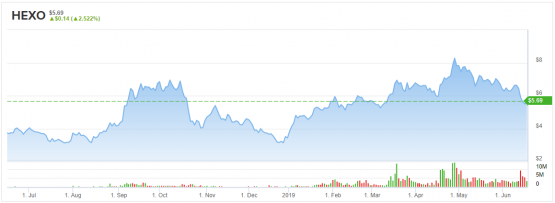Hexo: When the Bulls Aren’t Bullish Enough

Do you own shares of Canadian cannabis company Hexo (HEXO)? If so we've got good news and bad news. (And when we say "we," what we really mean is Canadian investment bank BMO Capital).
BMO's Tamy Chen put out a new research report on Hexo, the upshot of which was that Hexo was doing both better, and also worse, than anticipated -- depending on which aspects of Hexo's business you focused on. The analyst reiterates a Market Perform rating on ACB stock, with $9.00 price target. (To watch Chen's track record, click here)
Good news first: Hexo's new one million square foot greenhouse (Number 89) is ramping production "better than ... expectations," and also better than greenhouses operated by other licensed producers of marijuana (LPs). Chen explains that this is because, in contrast to other LPs, which have generally created their greenhouses by repurposing existing structures to the cultivation of marijuana, Hexo's "89" facility is a "greenfield build" -- a new structure, purpose-built for cultivating cannabis. Its "climate control infrastructure" is therefore more efficient. On top of that, Hexo has built up "multiyear" experience growing in greenhouses, whereas some of its competitors are still learning the ropes.
On the surface, this seems like unadulterated good news for Hexo. It's one reason Chen believes that Hexo will hit its target of doubling its revenue between Q3 and Q4 2019, and why the analyst has raised her Q4 sales estimate for the company to C$26 million -- and her FY 2019 sales estimate to C$58 million. Chen also raised her estimate for volume of marijuana to be sold in Q4 2019, and 2019 as a whole -- to 5,640 kilograms and 12,342 kg, respectively.
But here's where we get to the bad news: While Chen is raising her estimates for 2019 production, she is lowering estimates for 2020 to C$266 million -- up from 2019 levels, but not up as much as the analyst previously expected.
Why is that?
Simply put: Because Hexo's marijuana-cultivation is going so well, there's a risk that it may not have the ability to process this marijuana into higher value-added cannabis derivatives (such as oils for vaping). Here, Chen echoes fears voiced by other analysts recently, to the effect that Hexo's new Belleville processing facility may experience delays in obtaining the necessary licenses to begin production, and/or delays in ramping production. And if such delays do occur at Belleville, at the same time as "89" ramps marijuana production, Hexo's existing processing facilities in Quebec may be unable to cope with the supply coming out of "89."
Is this something that should worry investors, too? Perhaps.
Consider that Chen is currently modeling a significant increase in marijuana retail prices -- from average prices of C$4.50 per gram for recreational marijuana and C$7.94 per gram for medical marijuana in 2019, to C$5.30 for recreational, and C$8.75 for medical, in 2021. (That's about an 18% increase in expected prices for recreational pot, and 10% for medical, in two years' time).
And yet, with pot production ramping all across Canada, you'd ordinarily expect prices to fall as supplies increase, not rise, right? But that's not what the analyst is predicting!
In order for this to make sense, it seems likely the analyst is hoping Hexo will shift to processing and selling more value-added cannabis derivatives over time -- at higher prices, earning fatter profits. If, however, Hexo is prevented from processing all the marijuana it would like to, into these higher value-added products it wants to sell, then logically Hexo would be forced to sell more of the marijuana being produced at "89" as simple dried flower -- and at lower prices, with smaller profits.
When you think about the dynamics this way, Chen's decision to keep Hexo stock rated only "market perform" makes a lot of sense -- at least, until the uncertainty surrounding Belleville is resolved.
To read more on the nitty gritty of what’s going on in the rising cannabis industry, click here.
Read more on HEXO:
- A HEXO Bear Says the Stock Has More Room to Fall
- Should Cannabis Stock HEXO Be Bought on Weakness?
- Analyst Puts the “Hex†on Hexo Stock Ahead of Earnings
- Cannabis Stock Hexo Can Go a Bit Higher Here, but Caution Is Warranted
More recent articles from Smarter Analyst:
- Avoid Canopy Growth Stock Like the Plague; Here’s Why
- Market Delays Can Derail Aurora Cannabis (ACB) Stock
- Nvidia (NVDA): A Real Lift or a Dead Cat Bounce?
- Stay Away from Cresco Labs Stock Until the Smoke Clears